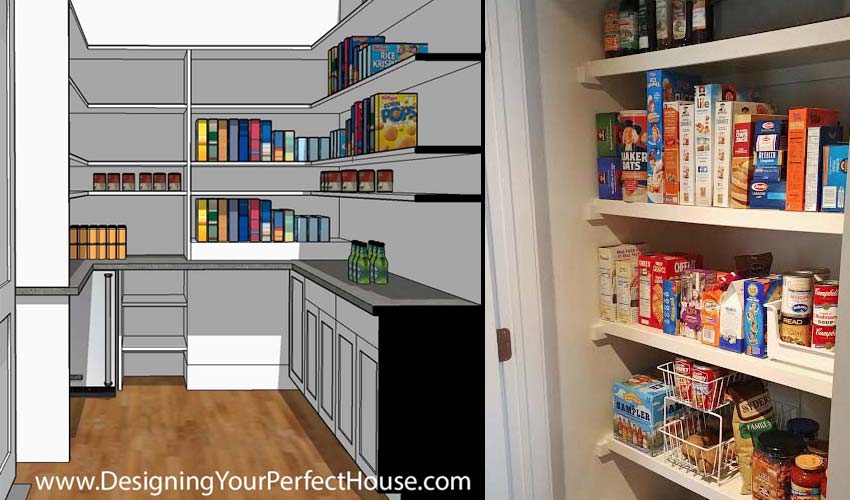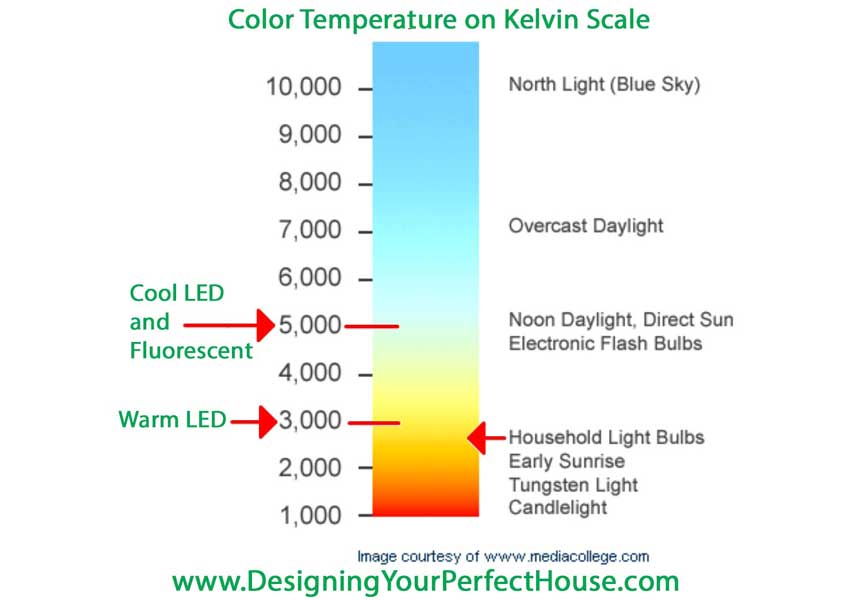Kitchen Pantry Closet Design Do’s and Don’t’s

Often, Kitchen Pantry Closets are small with limited space for all the things that will be stored within them. A well thought out Kitchen Pantry Closet Design can help you get the most out of the space you have.
A Little Planning Comes First
As I say about every home design project, the critical first step is planning. Do this by listing out the items you plan to store in your pantry. Measure the boxes and cans of food and paper items you typically buy figure out just how much space they need. Make an estimate of how many of these items you might want to store at any one time. Then calculate how many linear inches of shelf space you’ll need.
Your mission is to create a pantry closet design that wastes no space. If your shelves only need to be 8” high for canned goods and they are spaced at 12”, you won’t be able to fit in as many shelves. You’ll rob yourself of a valuable additional shelf or two.
Some things you may want to store in your pantry might be quite small. Consider including a few drawers or baskets on the shelves for smaller loose items. You may want a few mini-shelves or racks for spices. Of course, pantries are good places to store bulkier items, like paper towels and plastic storage containers.
List all of this in your plan. That will give you a target for how much shelving you’ll need to fit in to get everything you want. Use this list as your “yardstick” to evaluate your kitchen pantry design as you develop it.
There are many storage gadgets and devices that make your available space go farther. Lazy-Susans help with access to corner areas. Pull out shelves let you access the back area of deep shelves. Bins can help keep loose items together and organized.
Do some research to learn what devices are available and plan on including some of these in your pantry closet design. But don’t get carried away. The cost of these clever storage items can add up fast.
After you’ve done this planning, you may be faced with a dilemma. There is a good chance your list of needs might exceed the space available. Instead of trying to fit ten pounds into the proverbial five-pound sack, it’s time to decide what you don’t need. Think about what you could store farther away from the kitchen but still be convenient enough to use. House cleaning items, extra bulk paper items, light bulbs, and things you only access once a week or less could be stored in the laundry room or garage instead of taking up valuable space in your kitchen pantry. Preserve the kitchen pantry closet for more frequently used items.
Make Your Kitchen Pantry Design Work for You
Depending on how much area you have to work with, decide if your pantry closet design will be walk-in or not. We all love the concept of walk-in closets and pantries. But the floor space you will be walking in on might be space that could better serve you as shelf space. Remember, the primary objective in a pantry closet design is to waste no space.
Some kitchen pantry closets are extremely functional without being the walk-in variety. They might be a closet that is only a couple of feet deep, but reasonably wide. A closet like that can yield just as much linear footage of shelf space as a walk-in.
Another alternative to an actual pantry closet is to use tall pantry-type cabinets that go from floor to near the ceiling. These cabinets can store a lot of items, particularly if they are equipped with pull out can racks, shelving on the back of the doors, and built-in bins. However, they won’t work as well for storing bulky items as a full walk-in kitchen pantry closet will.
Too many times I see pantries with shelving that is too deep. It seems at first glance there is a lot of shelf area. But the “useful” area is less than it appears when you consider that deep shelves let items slip behind other items and get lost. We’ve all had the experience of cleaning out a cabinet and finding things we forgot we even had, with expiration dates from the last century.
Kitchen pantry closets magnify that problem since you can store so much in them. Your pantry closet design should avoid deep shelves if possible. I prefer a U-shaped design with shallower shelves along the inside walls of the pantry and a deep self at the middle of the U. The shallow side shelves are perfect for soup cans, bottles, boxes, and such. The deeper shelves at the back are great for bulky items like cases of drink bottles, big boxes of cereal, and bulky packages of paper products.
Graph paper is a perfect tool for sketching out your pantry closet design. Determine how many inches each grid represents, maybe three inches, and you can quickly try out various arrangements until you get the best one. Don’t focus just on the plan view. Sketch what’s called the elevation view, the view of the face of the wall, to arrange and space the shelves vertically. On this drawing you can also plan the locations of the additional storage devices.
Don’t forget the back of the pantry door. This can be a great place for a rack to hold small items or even hang a broom.
I am not a fan of adjustable shelves. First of all, they cost more than fixed shelves. And the reality is that people rarely adjust them later. It’s too much trouble to take everything off the shelf and move it. A better way to go is to do your planning properly and install shelves at the heights you need.
Start by positioning the lowest shelf 18” above the floor. The space below will be useful for heavy, bulky items like cases of drinks and multi-packs of paper towels. You could choose to place a shelf effectively on the floor. It can give the look of a full built-in stack of shelves. But you can save a few dollars by omitting that shelf.
Tall items can go on the bottom two shelves that might be spaced 16” vertically. Tall boxes and bottles go there. Above that, you might have a few rows of shelves that are 8” to 10” tall for cans and bottles. Above that you might have a couple of shelves that are spaced at 12” high. Then the top shelf can be open to the ceiling.
I also am not keen on wire rack shelving. I understand the logic that they don’t collect dust and stay cleaner. But they make it hard to place small items and keep them from tilting and wobbling. I like a good old-fashioned wood shelf with a thicker front edge to give the shelf added strength.
You can load them strong shelves up with heavy cans and they won’t bend out of shape. Solid shelves of particleboard with a plastic laminate surface, like melamine, will make them easier to clean. But particle board is not nearly as strong as plywood. So be sure to provide additional support for the shelves if you use it.
What about the Lighting in the Pantry?
A pantry needs good lighting. There is nothing worse than squinting in dim light while trying to read the tiny print on a label or read an expiration date. Simple LED lights are best. Choose one that throws light in a wide pattern. LED’s use much less electricity, last a long time, and do not generate as much heat as incandescent lights.
Just be sure to use LED’s with a color temperature between 2700K and 3000K and a CRI above 80 to let the colors of everything look right.

Ordinary fluorescents and 5000K LED’s are too cool. The light is bluish and reds and warm colors of the items in the pantry won’t show correctly. Food does not look as appealing under cool, bluish lighting.
One other tip is to install at least one electrical outlet in your pantry. With more and more rechargeable items in our households, like electric brooms or flashlights, it’s nice to have a convenient place to store them and keep them plugged in and charged up.
Thinking through the rue use of the pantry will guarantee a good result and give you the most efficient layout possible.
I hope this information is helpful to you. You might want to get yourself a copy of my best-seller, Designing Your Perfect House. It is chockfull of valuable tips and advice that will save you many times the cost of the book on your house building or remodeling project. You might also like The Well-Centered Home: Simple Steps to Increase Mindfulness, Self-Awareness, and Happiness Where You Live. It will show you how to make your home a happy place.

